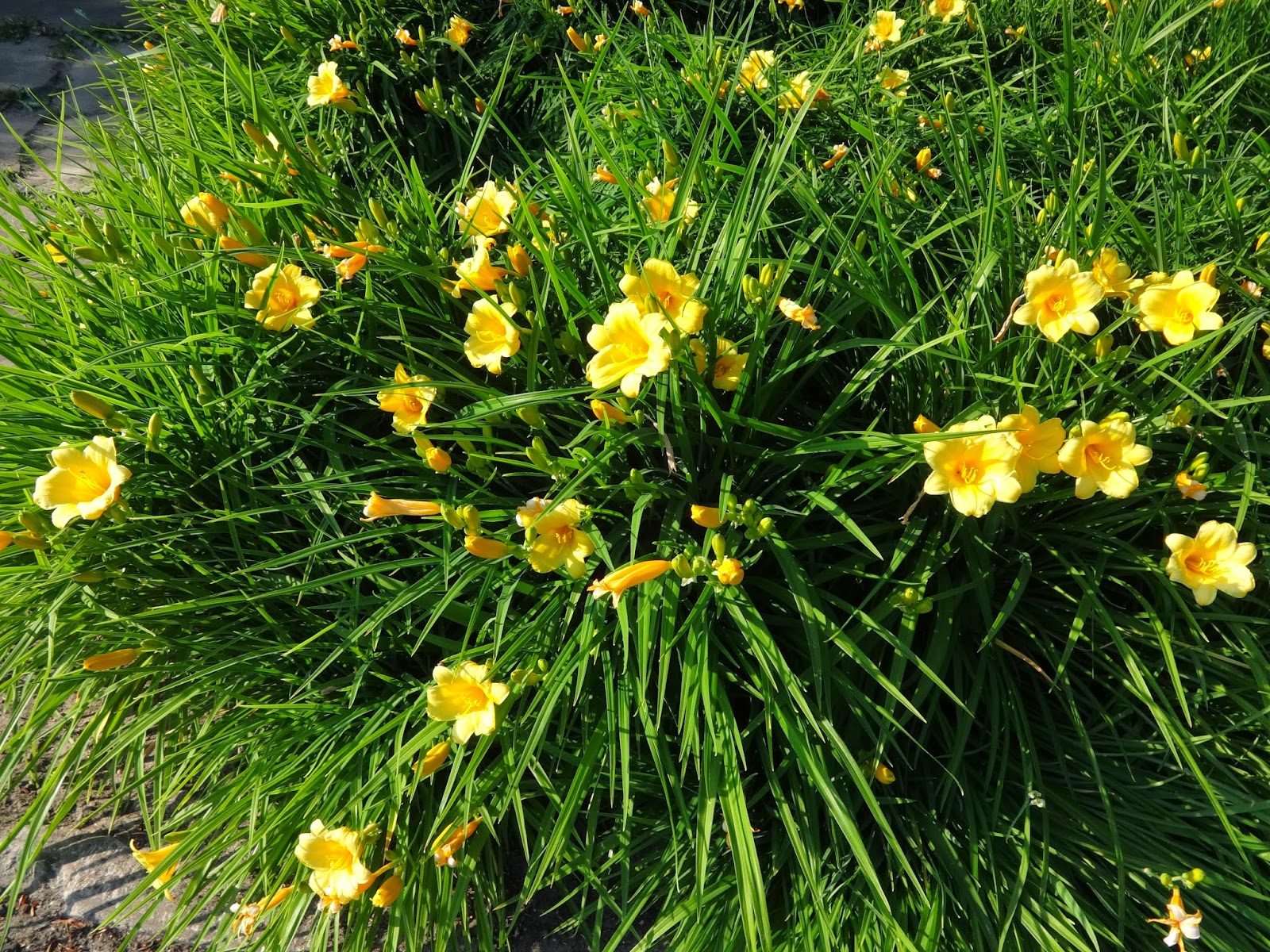 PLANT PROFILE
PLANT PROFILEDaylily is a perennial plant, growing in clusters that provide abundance of beautiful, and what not many people suspect, delicious flowers. Every single flower is open for one day only, hence it's name Daylily and Hemerocallis which means ''day-beautifull'' in greek. But before you go to to try it, please make sure it is the right one. The most important thing to avoid is to get mixed with Lilies. They both have basically same shape of flowers as they are closely related. Fortunately they differ in general appearance. Daylilies are growing in form of clumps of long leaves growing straight from the ground, while highly poisonous Lilies are creating single flowering stems with small leaves growing straight from the stalk. What is also important is that there are hundreds of cultivars of Daylilies and some of them are reported to be not palatable or iritate stomach. But don't worry, it is not that hard to find the right one, that have been used in China, Korea and Japan for centuries, both as a vegetable and medicine. Mainly there are two types of asian Daylilies, which in many regions of USA and Europe escaped from cultivation and become popular wildplants. One have orange/tawny flowers and is called Hemerocallis fulva, and second one is yellow, Hemerocallis flava. These are the safest for harvest of edible raw or cooked, flowers, buds, young greens and tubers. But you have to be carefull with them as well. Even though delicious in taste in bigger quantities they are laxative, and older uncooked leaves might couse hallucinations. Some people also are allergic to Daylilies. So if you want to try one of those two types for the first time or try some new variaties without certain recommentadion, take a small part, chew it, taste it and spit it out. If you feel fine after about hour, try to eat small piece, but do it with someones assistance in case of sever allergic reaction. Fortunately I didn't found any human death reports but there are some informations about poisoning of cattle and cats.
In Asia dried leaves and it's fibres are used to made sandals, ropes and even paper.
CULTIVATION AND HARVESTING
Daylilies are easy to grow perrennials growing up to 1,2m with flower stalks reaching even 2m hight. It can create a vast clumps, spreading through it's rhizomes, and so it can be easily propageted by division. This method of propagation is better from culinary point of view as it create exact clone of motherplant. While propagation from seeds is risky becouse of cross polination, very common among Daylilies. It can be fun though as sometimes hybrids might taste better than it's parents. It is a sun loving plant but tolerate moderate shade. It copes well with heats, temporary droughts and severe frosts (zones 3-9), but it is adviced to leave old dead leaves over winter as a natural cover. It can grow on nearly any soil, but prefer rich compost, neutral or slightly acid and quite wet soils. Leaves are best to gather when young, especially when they are just comming out from the ground in late winter or early spring. Older leaves are less atractive in both taste and texture, have stronger laxative effect and if eaten in excess uncooked, can couse hallucinations. Tubers are best from late fall to early spring, becouse of highest accumulation of nutrients, but can be digged up at any time of year. Buds and flowers can be picked at any time of development, most varieties are producing flowers from late spring to late summer. If some flowers will be left and the seed pods will start to develop, that plant may stop growing new flowers.
CULINARY USES
Young leaves, tubers, roots, buds and open flowers can be eaten raw, blanched or cooked in many ways. It can be added to salads, soups, stews, stir fries or used as a fillings. Flower buds while small and green, can be used like a green beans. Flowers can be dried and used as a thickening, fried in batter or turned into a jelly. Moderation is adviced because of laxative properties of uncooked green parts that if eaten in excess may lower ability to concentrate or even couse hallucinations.
MEDICINAL USES
Fresh leaves of Hemerocallis fulva acts sedative and might be used as a pain relief. Chinese are saing that it uplift the spirit and Chinese word for Daylily is synonym for ''forget-worry'', it is used as a treatment for post traumatic stress disorder, but consumed with excess it might couse hallucinations. It also have laxative properties.
Tubers and roots are antimicrobial, diuretic, laxative and are used to cure jaundice, hemorrhoids, constipation, pneumonia, also breast tumors and other form of cancer. It also kills parasitic worms that couse filariasis. Juice from roots is effective antidote in cases of arsenic poisoning.
Flowers are diuretic, depurative, febrifuge, antiemetic, sedative, antispasmotic, antidepresant and anodyne, in China it is used for this purpose even by women in childbirth. They are good source of protein, iron, beta-caroten and also contain rutin.In Japan both flowers and leaves are used to treat insomnia. Crushed petals or infusion made from flowers can be applied for sprains and bruises.
Sources
http://www.thesouthernherbalist.com/articles/Daylily.html
http://www.survivalschool.us/edible-medicinal-plant-uses/day-lily-hemerocallis-fulva/
http://practicalplants.org/wiki/Hemerocallis_fulva
http://www.kew.org/science-conservation/plants-fungi/hemerocallis-fulva-orange-daylily
http://www.floridata.com/ref/h/Hemerocallis_fulva.cfm
http://honest-food.net/2010/06/29/dining-on-daylilies/
http://brigittemars.com/other/day-lilies/
http://www.ncbi.nlm.nih.gov/pubmed/15172183
http://www.susunweed.com/Article_Liliacea-family.htm
http://blog.chestnutherbs.com/delectable-daylily
http://davesgarden.com/guides/articles/view/1055/#b
http://ipm.missouri.edu/MEG/2012/6/Daylily-Americas-Favorite-Perennial/
http://www.hgtvgardens.com/foraging/wild-man-dig-into-some-delicious-daylilies
http://books.google.pl/books?id=MaduhNghjb4C&pg=PA146&lpg=PA146&dq=hemerocallis+medicinal+uses&source=bl&ots=AJiDBVSNTE&sig=BCTHhZ2VwJgdTgyPEBu8NAXJj0w&hl=en&sa=X&ei=SkqpU8znBoXB7AbIiYGgAg&ved=0CCwQ6AEwAjge#v=onepage&q=hemerocallis%20medicinal%20uses&f=false
http://greentropicals.wordpress.com/2012/09/09/daylily-hemerocallis-fulva/
http://books.google.pl/books?id=10IMFSavIMsC&pg=PA2231&lpg=PA2231&dq=hemerocallis+medicinal+uses&source=bl&ots=7GbOv2KY7V&sig=eTio6bj5iWGW0yDoFOzQjgP3Efg&hl=en&sa=X&ei=IvGpU-3aN5Sp7Aai84HICg&ved=0CFAQ6AEwCDgo#v=onepage&q&f=false
http://www.teasofkyushu.com/health-forum/health-kwanso
http://books.google.pl/books?id=6jRsF1nOmqgC&pg=PA27&lpg=PA27&dq=hemerocallis+medicinal+uses&source=bl&ots=S_AjkT9TR5&sig=rrDwc4dWULK2Zf3EzGyVRNvc340&hl=en&sa=X&ei=4J2oU9SyINHy7Aa344G4Aw&ved=0CDcQ6AEwBDgU#v=onepage&q=hemerocallis%20medicinal%20uses&f=false
http://www.pfaf.org/user/plant.aspx?LatinName=Hemerocallis+fulva
















.JPG)


.JPG)















